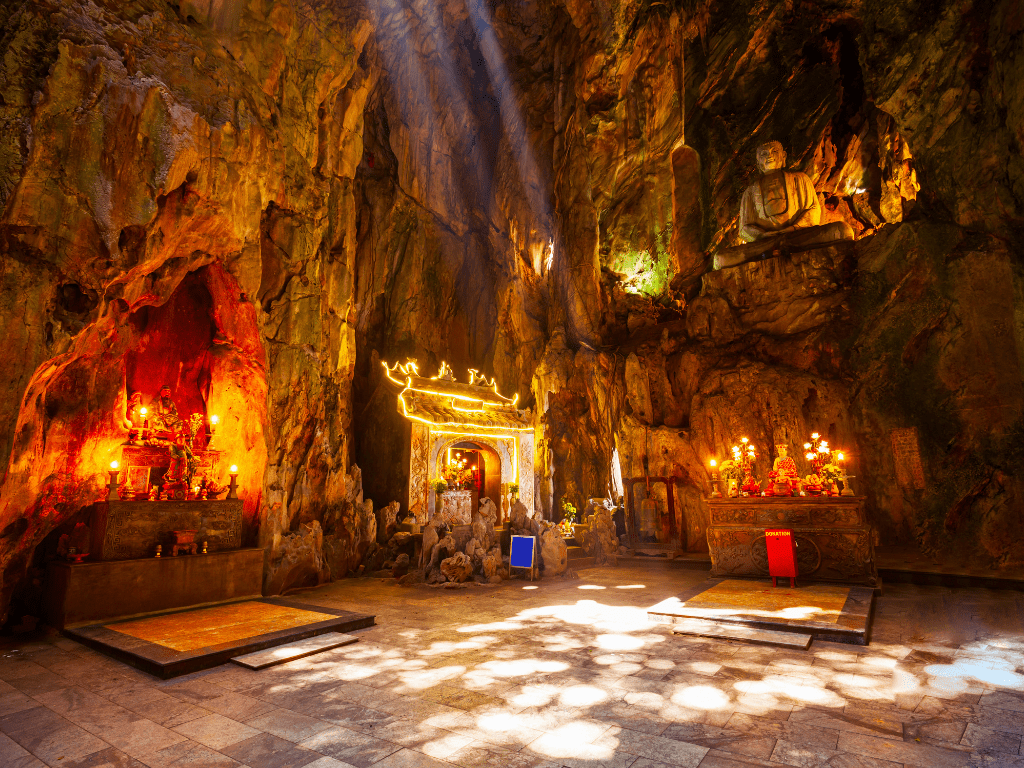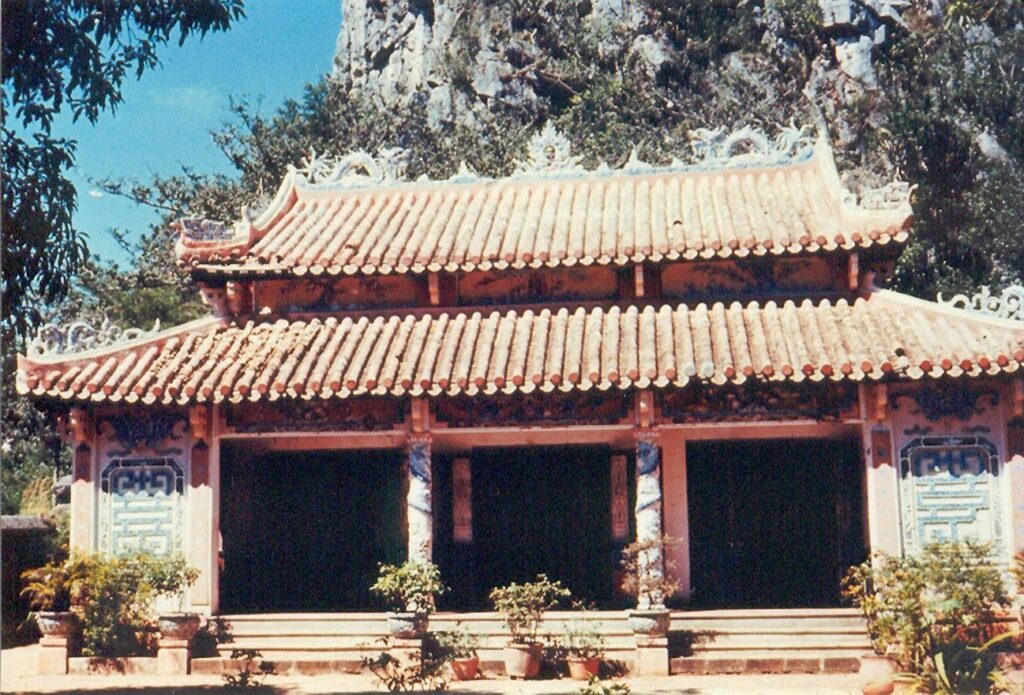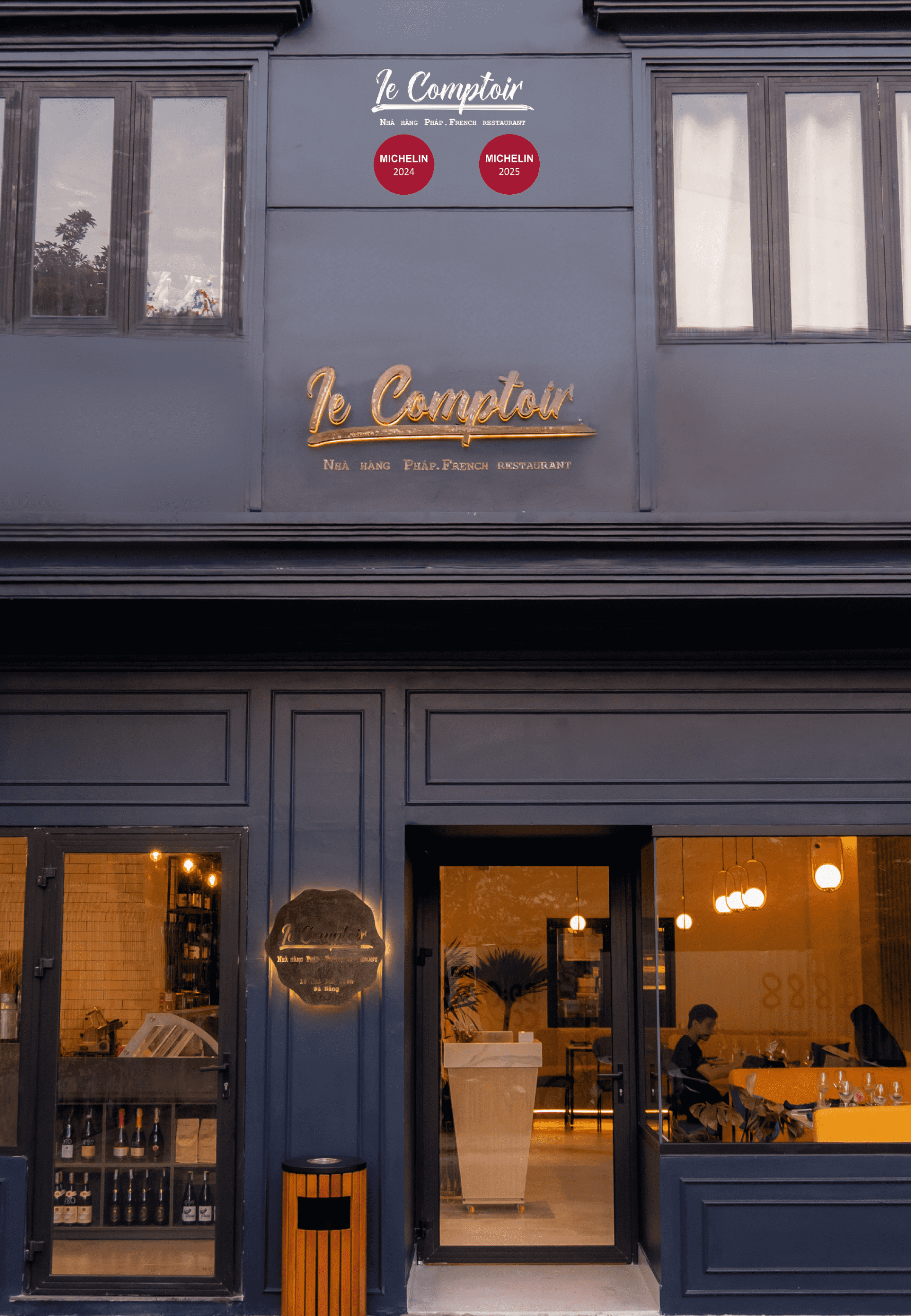It would be impossible to ignore Marble Mountain as one of the centers of Da Nang’s most spiritual values. For more than a century, there have been traces of Buddhism and the Champa culture. A place to transmit the spiritual, historical, and cultural values of this area is Marble Mountain.
The Spiritual Place
The Vietnamese have integrated various Vietnamese aspects of the spiritual culture of the Cham, most notably the devotion of the Cham people, in addition to preserving and promoting the traditional cultural values of the “ancestral homeland” Linh Son Thanh Mau at Tang Chon cave, Ngoc Phi and Loi Phi in Huyen Khong cave. These saints are truly the Cham people’s goddesses of the Po Inu Nagar religion. The statue she is revered as is still made of sandstone and is decorated with vermilion paint, gilt, garments, brilliant crown.
Marble Mountain in Dang Trong (The Cochinchina of the Nguyễn Lords’ Period) developed as a Buddhist center between the 17th and 19th centuries. It had a complex network of shrines and temples and pagodas could be built practically anywhere there was a mountain or cave. Pagodas, temples were built as shrines to Buddha, gods, and spiritual symbols of both Vietnamese and Cham people, where several old temples constructed throughout various historical eras can be found. There are currently 14 huge and minor pagodas in the picturesque area of Ngu Hanh Son. There are five pagodas and towers on Water Mountain (Thuy Son): the Tam Thai Pagoda, the Linh Ung Pagoda, the Tam Ton Pagoda, and the Tu Tam Pagoda. There are two pagodas on Metal Mountain (Kim Son), three pagodas on Fire Mountain (Hoa Son), and four pagodas on Earth Mountain (Tho Son). Among them are Tam Thai Pagoda and Linh Ung Pagoda, which were ordained as National Temple by King Minh Mang in 1825.
Since the Nguyen Dynasty established Thua Thien Hue its capital in 1802, Da Nang has served as a crucial barrier between the North and the South to protect the dynasty. Since it played a significant part, Da Nang attracted special attention from the Nguyen Dynasty. The kings frequently came here and enjoyed the area’s stunning scenery, which included the well-known Marble Mountains. Particularly King Minh Mang made three visits and contributed greatly to the building of Marble Mountain. During his final visit in 1837, King Minh Mang issued a proclamation renaming this mountain range Ngu Hanh Son.
1. Linh Ứng Pagoda
On the mountain of Water Mountain (Thuy Son) stands the Linh Ung Pagoda. This is one of the three Linh Ung pagodas that have stories about protecting the citizens of Da Nang city is this one. The oldest pagoda in Marble Mountain, with a long history of more than a century. This pagoda has a significant historic value as well. Together with two other Linh Ung pagodas, the Linh Ung pagoda at Marble Mountain forms a star that surrounds Da Nang. Many people believe that the gods protect these three temples from storms and other natural disasters yearly.
Every year, a large number of travelers from all around the world come to this historic temple to pray and experience its nostalgic and spiritual beauty. This is more than just a tourist attraction; it also serves as a place of worship for the locals. The Linh Ung Non-Nuoc Pagoda has survived numerous ups and downs in the nation’s history while still retaining its original beauty and pure construction. Up to now, the pagoda has been recognized as a national historical and cultural relic.
In front of the three gates is the setting of Lumbini Garden, simulating the birthplace of Buddha Shakyamuni.
2. Huyen Khong Cave
Huyen Khong Cave, which is situated on the highest mountain in the Marble Mountains (Da Nang), is a location where individuals can discover their own spiritual roots among the revered rocky mountains.
In addition to spiritual significance, Huyen Khong Cave has historical significance. During the resistance battle against the French, this served as the local insurgents’ unofficial base of operations. The US Army used Huyen Khong Cave as a commando training facility and a camp for many US troops during the Vietnam War. In 1968, the Liberation Army drove them from this location, and Huyen Khong was transformed into a first aid facility and a safe haven for injured soldiers.
Lord Ngoc Thien Y An Na is seated on the altar in Huyen Khong cave. Many people used to visit this location in the past to pray for God’s mercy on ladies who weren’t pregnant before entering the cave and drinking water from the stalactites. Such traditions don’t exist anymore.
Besides that, there is a temple called “Miếu Ông Tơ Bà Nguyệt” which is the same as the Cupid angle in Westen. Some people believe that if you come here and pray with them your wants, maybe they can come true. and you no longer be alone anymore.
3. Tam Thai Pagoda
The Tam Thai Pagoda’s description states that this temple, which was previously known as Tam Thai Tu, was erected in 1630 and was governed by Hung Lien monk – a Chinese monk. Under King Minh Mang dynasty, the pagoda was rebuilt and designated, re-named Quoc Tu in 1825. An Lang served as the pagoda’s monk from 1907 till 1995 and then Thich Tri monk took over. The pagoda was conserved and kept up during all of these times. The pagoda still has numerous priceless artifacts and the original construction from long ago. For instance, the Tam Thai Tu signboard, a gift from King Minh Mang, is a bronze pot or a metal card in the shape of a heart.
There are numerous justifications for Tam Thai Pagoda’s existence when it comes to its history. King Nguyen Anh’s story is still the one that gets the most attention in that. King Nguyen Anh once fled to an island in the East Sea while being pursued by the Tay Son army. He briefly returned to the mainland before seeking safety in Marble Mountain. He prayed to the Buddha while he was there, promising to rebuild and restore this temple if one day he could defeat the Tay Son army. When his wish came true, he was crowned king and asked King Minh Mang to restore the temple in his honor.

















I served as a guard for the Da Nang east transmitter site directly south of the Marines 3rd division Base. It was on the south side of the mountain as well.
There was a small village there that bordered us where marble was being mined and carved into grave stones an religious figures. My duty went from March 1968 to March 1969. I have fond memories of some of the Vietnamese people I met there. I have been told there is now a large Resort built on the area I was stationed on.
Robert Winkley – US Navy Da Nang East Security 1968-1969